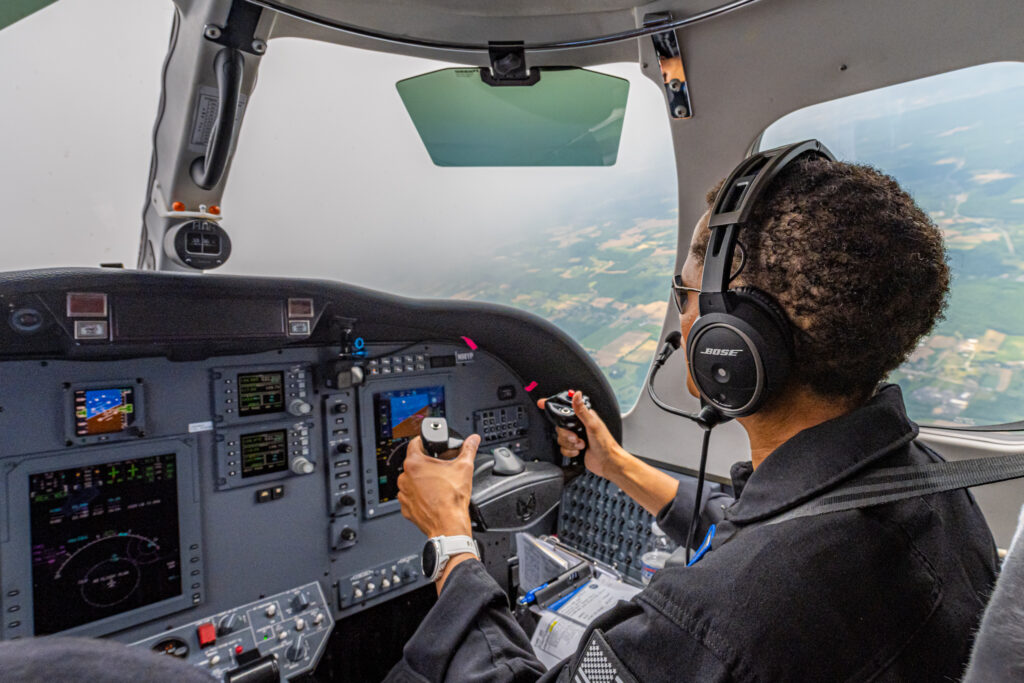Last month, Dr. Sian Proctor—a 51-year-old geoscientist, community college professor and artist—became the first Black woman to pilot a spacecraft and the fourth Black American woman to go to space.

On September 15, SpaceX made history, launching the first all-civilian mission into orbit. Three days later—after circumnavigating Earth 47 times at the unfathomable speed of 17,500 miles per hour—the Crew Dragon capsule splashed down in the Atlantic Ocean off Florida’s Space Coast, ushering in a new era of human spaceflight.
Flying at the record-breaking altitude of 367 miles, higher than the International Space Station and Hubble Space Telescope, the Inspiration4 mission was also a giant leap for womankind: Dr. Sian Proctor, a 51-year-old geoscientist, community college professor and artist, became the first Black woman to pilot a spacecraft and the fourth Black American woman to go to space.
Born in Guam, where her father worked at the tracking station during NASA’s Apollo missions, Proctor dreamed of being a fighter pilot. Though she pursued a different life path, she always nurtured her lifelong passion for space exploration.
In 2009, in her late 30s, as her career in science education flourished, a friend convinced Proctor to apply for NASA’s astronaut program. While ultimately unsuccessful, Proctor was a finalist among the 47 applicants selected from 3,500 submissions. Disappointed but undeterred, Proctor spent 21 years as a professor teaching geology, sustainability and planetary science at a community college in Phoenix, Arizona.
In 2013, she served as an analog astronaut—individuals who work in a simulated space environment on Earth—for the first NASA-funded Hawai’i Space Exploration Analog and Simulation (HI-SEAS) mission, investigating food strategies for long-duration spaceflight and future missions to Mars. Proctor obtained her pilot’s license at age 36 and has since served as a major in the Civil Air Patrol as the aerospace education officer for its Arizona wing.
From Mae Jemison to Sian Proctor: Representation Matters
In 1992, Mae Jemison became the first African American woman to travel to space, followed by Joan Higginbotham and Stephanie Wilson, who flew on NASA shuttle missions thereafter.

“I received a really lovely note from Mae Jemison congratulating me on the Inspiration4mission,” Proctor said. “To have her, the first Black female astronaut, tell me she was proud of my accomplishment was amazing.”
The day before launch, Proctor received an unforgettable call: Former First Lady Michelle Obama rang to acknowledge her achievement and wish the crew well on their mission.
“You are making history,” Obama said to Proctor and her smiling crewmates.
“That conversation meant everything to me,” Proctor told Ms. “Knowing I was now in a position to inspire millions of people I’ve never met through my story and this experience, I wanted to pay that back to someone who inspires me.”
Battling the Imposter Within
In the months before launch, Proctor endured intensive training with her crewmates—mission funder Jared Isaacman, physician assistant and pediatric cancer survivor Hayley Arceneaux, and Air Force veteran and engineer Christopher Sembroski.

During training, Proctor struggled to overcome self-doubt: “I learned to be patient with myself in managing my imposter syndrome—the fear of not being good enough, not being accepted, saying the wrong thing.”
This was critical as she trained to serve as mission pilot.
“I essentially had to become a systems engineer in six months,” Proctor said, laughing.
Return of the J.E.D.I.: A Just, Equitable, Diverse and Inclusive Space
True to her motto, Space2inspire, Proctor uses her Afrofuturist artwork to encourage conversations about creating a “J.E.D.I.” future: a just, equitable, diverse and inclusive space for all of humanity to advance spaceflight.
She believes science and art aren’t the binary endeavors we’ve come to think of them as, but inextricably linked: “People often think science isn’t art, but it is. Our built environment is art. How we interact with our world is art.”
While on orbit, Proctor painted and wrote poetry. When she saw Earth from space for the first time through the cupula—the domed window on the Dragon capsule’s nose, offering the crew a 360-degree view of our planet—it was a breathtaking moment.

“It’s this beautiful swirling portrait, in motion and alive—and we humans are controlling the destiny of what this portrait’s going to be,” she said. “That’s exciting.”
Designed to advance human spaceflight and exploration while simultaneously addressing challenges we face on Earth, the Inspiration4 mission undertook medical research and raised over $235 million for St. Jude Children’s Research Hospital.
Mission(s) Accomplished

Proctor’s focus on empowering women and girls of color to achieve their dreams is invigorating a new generation of Americans at the dawn of a new space age that’s opening to more and more people.
“Representation matters, and it’s good for everyone,” Proctor said.
Proctor tells girls and young women interested in science, technology, engineering, art and mathematics (STEAM) to surround themselves with friends who bring out the best in them. When offering career advice, she suggests choosing a question to answer or problem to solve rather than focusing too much on a specific career track.
“It’s not about becoming a geologist or an engineer,” she said. “Become the kind of creative person that can solve problems because you have a wide-ranging toolkit to pull from. And surround yourself with people who bring different skills to help address that problem.”
Proctor also has inspiring words for older women.
“Being a female in my 50s, there were times I felt the best years of my life had passed me by,” she said. “But the dreams of your childhood, the goals you maybe weren’t able to achieve as a young adult. … They can absolutely still be realized.”
Her advice: Dream big, persevere and make it happen. “Don’t just imagine it; do it.”
A Phoenix Rising
As launch day loomed, Proctor felt the weight of the hopes and dreams she carried for people of color, especially Black women.
“I’m trying to open the door for [them],” she said. “I couldn’t let them down.”
After splashdown, Proctor emerged from the capsule triumphant, with a wide, effortless smile.
“I was feeling pure joy. … I did it,” she said. “That was the phoenix rising. That was me becoming.”
Life After Space
Proctor embodies the advances women of color continue to make in the sciences and beyond—but the story doesn’t end there for this newly winged commercial astronaut.
“Having achieved the pinnacle of my life’s goals, I’m now in a position to inspire others,” she said, “which is just as important.”
The Netflix and Time Studios docuseries “Countdown: Inspiration4 Mission to Space,” which follows the crew along their inspiring journey, is streaming now.
To donate to St. Jude, visit stjude.org/inspiration4.
Up next:





